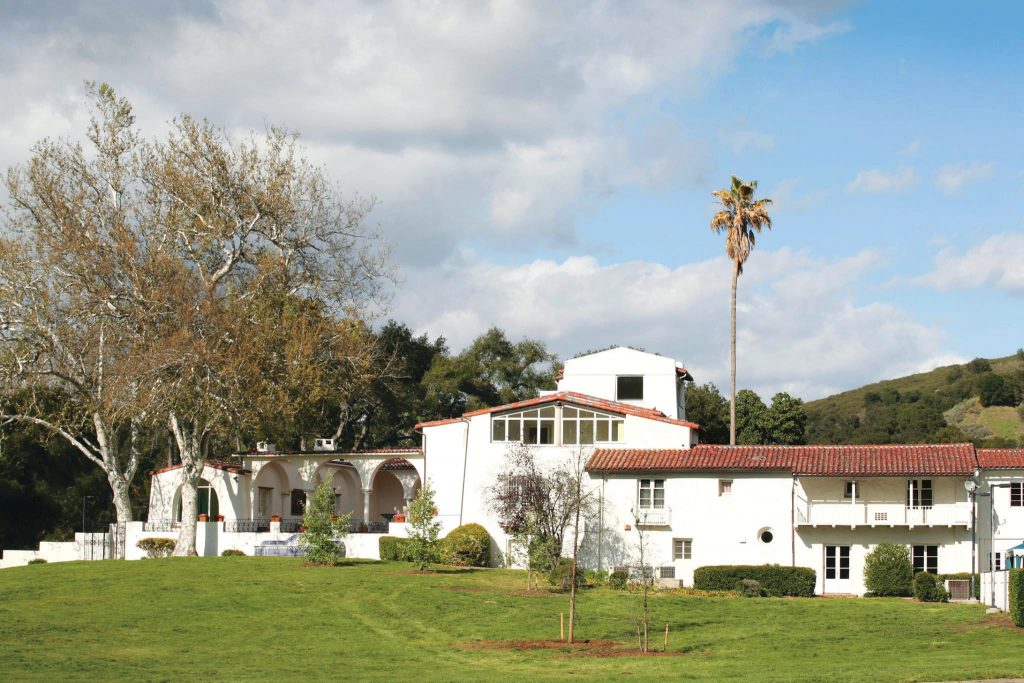King Gillette Ranch has a storied history
Source of this article: The Thousand Oaks Acorn, July 11, 2019
King Gillette Ranch is an idyllic 588-acre parcel of parkland that sits on Las Virgenes Road opposite the entrance to Malibu Creek State Park, but its status as protected public land dates back less than 20 years.

The King Gillette Ranch, above, now houses the visitor center for the Santa Monica Mountains National Recreation Area.
The history of the storied property stretches back through 9,000 years of Chumash habitation, the Spanish conquest and the Mission era. Within the last 100 years it has changed hands five times, and before it became public land it housed a seminary, a New Age religious order and a university.
King Gillette era
In 1926, millionaire businessman King Gillette bought 360 acres in Las Virgenes Canyon to build the retirement home of his dreams.
At the time, King Gillette, who made his fortune through the invention of the disposable Gillette razor blade, was one of the wealthiest men in the world.
According to a 2007 study by the Santa Monica Mountains Conservancy, Gillette’s property outside Calabasas overlapped with the historical boundaries of the Chumash village of Talepop.
The razor-blade tycoon commissioned Wallace Neff, known as the architect of California’s Golden Age, to design a Spanish Colonial Revival-style mansion.
The residence, which had 25 rooms with a fountain at the heart of its layout, was completed in 1929.
Soon after, in October of that year, Gillette’s fortune fell with the stock market crash, and while he was able to hold on to the ranch, he became seriously ill in the years that followed and died in July 1932.
Clarence Brown era
In 1935, Gillette’s widow, Atlanta, sold the property to MGM film director Clarence Brown, one of whose films was “Anna Karenina” starring Greta Garbo. Brown made some changes to the ranch, adding a movie projection room, a swimming pool and a small airstrip.
The Claretian era
When he retired from the film industry in 1952, Brown sold the ranch property to a Catholic religious order, the Missionary Sons of the Immaculate Heart of Mary, more commonly known as the Claretians. The Claretian Theological Seminary deeded a portion of the property to Immaculate Heart Claretian Novitiate to prepare young men to take their religious vows.
The Claretians built a threestory dorm and a novitiate building with a library and a chapel in 1954 and 1955. They built an addition to the Gillette residence that included a lounge and dorms. A hay barn was also added.
As the number of seminarians began to dwindle from a high of 140 in the 1960s, the seminary leased parts of the ranch, including space to Thomas Aquinas College from 1971 to 1977.
The Claretians began trying to sell the property in the mid-1970s, when as few as 12 seminarians remained. When Malibu Creek State Park was acquired by the California Department of Parks and Recreation in 1974, there was public outcry that the King Gillette property was not made a priority for acquisition at the same time.
After residents opposed proposals to turn the ranch property into a housing subdivision, a cemetery and a Czechoslovakian theme park, the property sold in 1977 to the Church Universal and Triumphant.
The Church Universal and Triumphant era
The CUT, a New Age religious order that espoused beliefs in mysticism, the paranormal and alchemy, renamed the property Camelot.
CUT made numerous changes without the required building permits. The garage was converted into a high school, and the horse stables were turned into offices. Up to eight plywood treehouses were built. The steel water tank was converted into a dormitory.
Soka University era
The CUT moved to a ranch in Montana and in 1986 sold the ranch to Japan’s Soka University, which began to operate a small language school on the ranch and planned to expand the American branch to an enrollment of up to 5,000. The expansion was opposed by some residents as well as the Santa Monica Mountains Conservancy.
By that time, California State Parks had made the acquisition of the King Gillette Ranch a priority, so that together with the National Park Service it could establish a joint headquarters and visitor center at the site.
The public parkland era
After years of legal wrangling, Soka University, which had expanded to include a public policy research center and a graduate school, opened a campus in Aliso Viejo in Orange County in 2001.
In 2005, the Mountains Recreation and Conservation Authority bought the site, which had grown to 588 acres, for $35 million. Soka vacated the property in 2007.
King Gillette Ranch, which is managed by the Mountains Recreation and Conservation Authority in partnership with the Santa Monica Mountains Conservancy, is now home to the Anthony C. Beilenson Visitor Center.
The public can take part in educational programs, picnicking, hiking and bird-watching at the site.
The historic site is available to rent for special events, including concerts, parties and weddings.
For more information, go to mrca.ca.gov.




1 Comment
king gillette · February 7, 2022 at 8:35 pm
[…] King Gillette Ranch houses the joint headquarters and visitor center for California State Parks and the National Park Service in the Santa Monica Mountains. It’s named for millionaire businessman King Gillette (inventor of the disposable razor blade) who owned the property from 1926 to 1939 and built some of the structures on the 360 acre property. There are easy hiking trails and lots of places to picnic (and sketch). […]